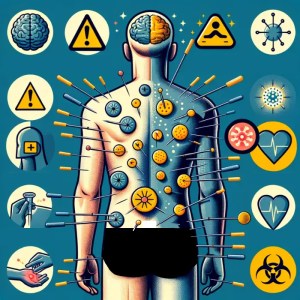- Introduction to Acupuncture Health Insurance Coverage, Benefits and Risks
- The Essence of Acupuncture: A Healing Art Evolved
- Understanding the Different Facets of Acupuncture
- Evaluating the Risks: A Critical Look at Acupuncture
- Is Acupuncture the Right Choice for You?
- Preparing for Your Acupuncture Session
- Post-Treatment Expectations
- How Health Insurance Addresses Acupuncture Coverage
- Additional Insights into Health Plan Coverage
- FAQs: Acupuncture and Health Insurance Coverage
- 1. Is Acupuncture Covered by Health Insurance in the US?
- 2. What Conditions are Typically Covered by Insurance for Acupuncture Treatment?
- 3. Do I Need a Referral from My Doctor to Get Acupuncture Covered by Insurance?
- 4. How Many Acupuncture Sessions Does Insurance Typically Cover?
- 5. Are There Any Out-of-Pocket Costs for Acupuncture with Insurance?
- 6. Do Medicaid and Medicare Cover Acupuncture?
- 7. Can I Use Acupuncture for Pain Relief After a Car Accident Under My Insurance?
- 8. How Do I Find Out if My Insurance Covers Acupuncture?
- 9. What Should I Do if My Insurance Doesn’t Cover Acupuncture?
- 10. Are There Special Programs for Acupuncture Coverage?
- Conclusion to Acupuncture Coverage with Health Insurance
Introduction to Acupuncture Health Insurance Coverage, Benefits and Risks
In recent years, acupuncture, an ancient Chinese healing art, has gained remarkable traction in the United States as a legitimate and popular form of alternative healthcare. Its unique blend of traditional methods and modern medical understanding makes it an intriguing option for those seeking relief from chronic pain, stress, and a myriad of other health issues. However, the intricacies of health insurance coverage for acupuncture can be as complex as the practice itself. This comprehensive article aims to unravel these complexities, providing insightful information on the essence of acupuncture, its evolution, benefits, potential risks, and, most importantly, its interaction with contemporary health insurance plans.

Understanding how health insurance in the US covers acupuncture is vital for anyone considering this form of treatment. As the healthcare landscape continues to evolve, more individuals are turning towards alternative therapies, making it increasingly important to be well-informed about insurance policies and their implications on such treatments. This article delves deep into the realms of acupuncture, offering a detailed look at how it’s integrated into modern medical treatments and how health insurance plans typically approach its coverage. Whether you are new to acupuncture or considering it as part of your healthcare regimen, this guide will equip you with the necessary knowledge to navigate the coverage options available through your health insurance plan.
The Essence of Acupuncture: A Healing Art Evolved
Historical Roots and Modern Transformation
Acupuncture, a cornerstone of traditional Chinese medicine, has a rich history spanning thousands of years. Originally based on the concept of balancing the body’s energy flow, or Qi, it has transcended its cultural origins to become a globally recognized therapeutic practice. In the United States, acupuncture’s journey from an exotic curiosity to a respected form of alternative healthcare is a testament to its efficacy and adaptability.
Modern acupuncture in America marries ancient wisdom with contemporary scientific understanding. This integrative approach combines the age-old practice of inserting fine needles into specific body points with a thorough understanding of human anatomy and modern medical practices. Such a fusion not only broadens acupuncture’s appeal but also enhances its credibility and effectiveness in treating a range of conditions.

Advancements in Acupuncture Techniques
The evolution of acupuncture is marked by significant advancements in both technique and safety:
- Safer Needle Practices: In line with modern medical standards, acupuncture now exclusively uses sterile, single-use needles. This shift drastically reduces the risks of infection and ensures a safe experience for patients.
- Incorporation of New Techniques: Contemporary practitioners often enhance traditional needle placement with adjunctive techniques. These include the application of mild electrical impulses (electroacupuncture) and the use of heat (moxibustion), which are believed to intensify the therapeutic effects.
- Integration with Western Medicine: Many acupuncturists work alongside conventional medical professionals, providing a holistic approach to patient care. This collaboration allows for a more comprehensive treatment plan, particularly for chronic conditions unresponsive to standard medical treatments.
Acupuncture’s Expanding Role in Modern Healthcare
Acupuncture’s role in modern healthcare extends beyond pain management. Research and clinical studies have shown its potential benefits in areas such as stress reduction, immune system enhancement, and improving overall wellness. Its growing acceptance by the medical community and inclusion in various integrative medicine programs across the U.S. highlights its significance as a complementary treatment modality.
Understanding the Different Facets of Acupuncture
Emphasis on Safety in Modern Acupuncture
Modern acupuncture has made significant strides in ensuring patient safety, a cornerstone of its widespread acceptance. Here are key aspects of these safety measures:
- Sterile, Disposable Needles: A crucial advancement in modern acupuncture is the universal adoption of single-use, sterile needles. This practice virtually eliminates the risks of infections and cross-contamination, aligning acupuncture with the rigorous safety standards of contemporary healthcare.
- Regulated Practice Standards: Acupuncturists in the United States are required to adhere to strict guidelines and licensing requirements. These regulations ensure that practitioners are well-trained and knowledgeable in both traditional acupuncture and basic medical sciences, further safeguarding patient well-being.
Innovations in Acupuncture Techniques
As acupuncture continues to integrate into modern medical practices, several innovative techniques have emerged, enhancing its effectiveness and appeal:
- Electroacupuncture: This technique, where mild electrical currents are passed through acupuncture needles, has shown promising results in pain relief and rehabilitation therapy.
- Acupressure and Laser Acupuncture: Alternatives to traditional needle acupuncture, such as acupressure and laser acupuncture, offer needle-free options for patients who are needle-phobic or have specific contraindications for needle use.

Understanding and Mitigating Risks
While acupuncture is generally safe, awareness of its potential risks is essential:
- Risk of Minor Side Effects: The most common side effects include bruising, soreness, or minor bleeding at the needle sites. These are typically mild and transient.
- Rare but Serious Complications: In very rare cases, there can be more serious complications such as organ injury or infection. However, these are extremely uncommon, especially when treatment is administered by a licensed and experienced practitioner.
- Special Precautions: Certain conditions require special consideration. For example, individuals with pacemakers should avoid electroacupuncture, and those with bleeding disorders or on blood thinners should discuss potential risks with their healthcare provider.
Evaluating the Risks: A Critical Look at Acupuncture
Understanding Potential Side Effects
While acupuncture is widely recognized for its safety and minimal side effects, it’s important to acknowledge and understand the potential risks involved. Common side effects reported include minor bleeding, bruising, and soreness at the needle insertion sites. These symptoms are typically mild and transient, resolving without additional intervention.
Rare but Serious Risks
Acupuncture’s safety profile is generally high, especially when performed by licensed and experienced practitioners. However, rare but serious complications can occur, including:
- Infection: Although rare due to the use of sterile, disposable needles, there’s still a minimal risk of infection.
- Organ Injury: Very rarely, if needles are improperly placed, there’s a risk of puncturing organs, particularly in the chest or back areas.
- Central Nervous System Injuries: Though extremely uncommon, there have been isolated reports of acupuncture needles affecting the central nervous system.
Precautions and Contraindications
Certain individuals should approach acupuncture with caution or discuss it thoroughly with their healthcare provider:
- Individuals with Pacemakers: Acupuncture involving electrical stimulation can interfere with pacemaker operation.
- Pregnant Women: Certain acupuncture points may stimulate labor, posing a risk for premature delivery.
- Those with Bleeding Disorders or on Blood Thinners: Increased risk of bleeding or bruising may occur.
Making Informed Decisions
Patients considering acupuncture should be fully informed about these risks. Consulting with a healthcare provider and choosing a licensed acupuncturist who follows the safety guidelines are crucial steps in ensuring a safe and beneficial acupuncture experience.

Is Acupuncture the Right Choice for You?
Determining whether acupuncture is suitable for your specific needs involves a few steps:
- Consultation with Your Doctor: It’s essential to view acupuncture as a complement to, not a replacement for, conventional medical care.
- Choosing the Right Practitioner: Research, read reviews, and seek referrals just as you would for any other healthcare professional.
Preparing for Your Acupuncture Session
What to Expect During Your First Visit
Your initial acupuncture session is an important step towards your wellness journey. Here’s what you can typically expect:
- Initial Consultation: Your acupuncturist will start with a detailed discussion about your medical history, current health concerns, and treatment goals. This information helps tailor the acupuncture treatment to your specific needs.
- Physical Examination: Depending on your health issues, the practitioner may conduct a physical exam, focusing on the areas of pain or discomfort.
The Acupuncture Procedure Explained
Understanding the procedure can help alleviate any apprehensions:
- Dress for Comfort: Wear loose, comfortable clothing to your session. Depending on the areas to be treated, you may be asked to change into a gown.
- Needle Insertion: Acupuncturists insert 5-20 thin, sterile needles into specific points on the body. While some people feel minimal discomfort upon needle insertion, many feel no pain at all.
- Needle Manipulation: Your practitioner may gently move or twirl the needles after placement or apply heat or mild electrical pulses.
- Relaxation Time: Once the needles are in place, you’ll rest for 10-20 minutes. During this time, patients often experience a deep sense of relaxation.
Post-Treatment Care
After the session, it’s common to feel relaxed or rejuvenated. Here are some post-treatment tips:
- Hydration: Drinking water helps flush out any released toxins from the body.
- Rest: If you feel particularly relaxed, allow yourself some time to rest and rejuvenate.
- Monitor Your Body: Pay attention to how you feel over the next few days and note any changes in your symptoms.

Post-Treatment Expectations
Immediate Aftereffects
Post-acupuncture, patients often experience a profound sense of relaxation, sometimes described as a peaceful euphoria. This feeling can last for the remainder of the day or even the week, potentially leading to improved sleep quality. Some may feel energized, tackling daily tasks with a renewed sense of vigor, while others may prefer to rest and recuperate.
Physical Responses
- Soreness: It’s common for the areas where needles were inserted to feel sore or heavy, indicating continued therapeutic effects.
- Bruising: Occasionally, needles can cause minor bruising, but these are generally painless and resolve within a few days.
- Light-headedness: A few patients might experience light-headedness or dizziness post-treatment. This typically resolves quickly and is not a cause for concern.
Detoxification Symptoms
Some individuals may notice signs of detoxification, such as increased urination, changes in bowel movements, or even slight headaches. These symptoms are indicative of the body’s metabolism elevating and toxins being eliminated, helping to return the body to a state of equilibrium.
Emotional and Sleep Changes
- Emotional Sensitivity: A heightened emotional response can sometimes occur post-treatment, reflecting the body’s healing process.
- Sleep Improvements: Many patients report better sleep patterns following acupuncture sessions due to its anxiety-reducing and relaxation-inducing effects.
Managing Pain and Discomfort
Especially for those seeking relief from chronic pain, immediate relief can vary. Some experience significant pain reduction shortly after treatment, while others may notice a gradual improvement. It’s not uncommon for the pain to initially increase before it decreases, often indicative of the body’s healing response.
Post-Treatment Care Recommendations
- Gentle Exercise: Light activities like walking or stretching can aid in maintaining circulation and reducing pain symptoms.
- Hydration: Drinking plenty of water post-treatment assists in the detoxification process.
- Nutrition: Consuming warm, nourishing foods can further relax the body and support healing.
Avoiding Certain Activities
After acupuncture, it is advised to avoid:
- Strenuous Exercise: Intense physical activity can disrupt the body’s healing process.
- Extreme Temperature Changes: Activities like hot yoga or cold showers might impede treatment results.
- Stressful Situations: Stress can counteract the relaxing effects of acupuncture.
Importance of Follow-up
Continuing with follow-up appointments is crucial for long-term relief, especially for chronic conditions. The frequency and consistency of these treatments play a significant role in their effectiveness and in achieving sustainable benefits.

How Health Insurance Addresses Acupuncture Coverage
Understanding Insurance Coverage Variability
The coverage of acupuncture by health insurance in the United States can vary significantly based on individual insurance plans. Details such as the number of covered visits, applicable copays or deductibles, and the types of services covered can differ greatly. Some plans might require pre-authorization or a referral from a primary care physician. The extent of coverage ranges widely among insurance plans, from generous to limited or non-existent in some cases.
Types of Conditions Covered
Many insurance companies offer coverage for acupuncture treatments for a range of conditions. These can include chronic pain, nausea, addiction, depression, insomnia, dental pain, menstrual cramps, and various other health issues. It’s important to contact your insurance provider to confirm if your specific condition is covered and under what terms.
Acupuncture Coverage in Different Health Plans
Private insurance companies like Aetna, Blue Cross Blue Shield, and UnitedHealthcare, as well as government health insurance programs such as Medicare and Medicaid, provide varying degrees of coverage for acupuncture. For instance, Medicare covers up to 20 acupuncture treatments annually for chronic low back pain, while private insurers may have different policies and coverage limits.
Steps to Determine Your Coverage
To understand the specifics of your coverage for acupuncture, consider these steps:
- Check Your Insurance Provider’s Website: Look for in-network acupuncture providers and understand the coverage details.
- Call Your Insurance Provider: Contact customer service for information on covered acupuncturists and specific plan details.
- Consult Healthcare Providers for Recommendations: Your doctor or other healthcare professionals can suggest acupuncture providers covered by your insurance.
- Directly Contact Acupuncture Providers: Inquire about whether they accept your insurance plan and any out-of-pocket costs.
Alternatives if Acupuncture Isn’t Covered
If your plan doesn’t cover acupuncture or if it’s financially unfeasible, consider alternatives such as free or low-cost clinics, acupuncture schools offering reduced rates, community acupuncture clinics, or alternative treatments like acupressure.
Health Insurance Plans: A Partner in Health
Most health insurance plans provide extensive resources for their members, from online doctor consultations to a plethora of health resources. For those without insurance, various companies offer various plans to cater to different needs and budgets.
Additional Insights into Health Plan Coverage
Understanding your health plan’s coverage can be complex. Health insurance members should familiarize themselves with the specifics of their plan, including coverage for alternative treatments like chiropractic care and mental health services.
Ensuring You’re Covered
Always verify whether your provider is within your health plan network to avoid unexpected costs. Non-participating providers may lead to higher out-of-pocket expenses.

FAQs: Acupuncture and Health Insurance Coverage
1. Is Acupuncture Covered by Health Insurance in the US?
Yes, many health insurance plans in the US cover acupuncture. Coverage varies significantly between different insurance providers and plans. Companies like Aetna, Blue Cross Blue Shield, and UnitedHealthcare offer some level of coverage for acupuncture treatments, especially for conditions like chronic lower back pain.
2. What Conditions are Typically Covered by Insurance for Acupuncture Treatment?
Common conditions for which insurance may cover acupuncture include chronic pain, nausea, depression, insomnia, osteoarthritis, menstrual cramps, stress, anxiety, and more. However, the specific conditions covered can vary greatly between insurance providers and plans.
3. Do I Need a Referral from My Doctor to Get Acupuncture Covered by Insurance?
This depends on your insurance plan. Some plans might require a referral from a primary care physician or a specific diagnosis for acupuncture to be covered. It’s important to check with your insurance provider for their specific requirements.
4. How Many Acupuncture Sessions Does Insurance Typically Cover?
The number of sessions covered by insurance varies. Some plans may offer a certain number of sessions per year, while others might cover a set number of treatments for specific conditions. Medicare, for instance, covers up to 12 treatments in 90 days for chronic low back pain, with an additional eight sessions if improvement is shown, capping at 20 sessions annually.
5. Are There Any Out-of-Pocket Costs for Acupuncture with Insurance?
Even with insurance coverage, you might be responsible for copays, deductibles, or a percentage of the service fee. The exact costs can vary based on your insurance plan and the acupuncture provider’s policies.
6. Do Medicaid and Medicare Cover Acupuncture?
Yes, both Medicaid and Medicare have recently started providing coverage for acupuncture, mainly for chronic lower back pain. Medicare, for example, covers up to 20 visits per year for this condition.
7. Can I Use Acupuncture for Pain Relief After a Car Accident Under My Insurance?
Acupuncture can be a viable treatment after a car accident, and some insurance policies may cover it for post-accident care. However, this depends on the specifics of your insurance plan.
8. How Do I Find Out if My Insurance Covers Acupuncture?
To determine if your plan covers acupuncture, contact your insurance provider directly. You can find the customer service number on your insurance card. Be prepared to ask specific questions about coverage limits, conditions covered, and whether you need a referral or pre-authorization.
9. What Should I Do if My Insurance Doesn’t Cover Acupuncture?
If your insurance doesn’t cover acupuncture, you may explore alternative options like community acupuncture clinics for more affordable treatments or consider acupuncture schools that may offer services at reduced costs as part of their training programs.
10. Are There Special Programs for Acupuncture Coverage?
Some insurance providers have Affinity Programs that offer members discounted rates with certain acupuncturists. It’s worth inquiring with your insurance company about any such programs.
This FAQs section is designed to provide a comprehensive overview of the most common questions regarding acupuncture and health insurance coverage. It’s always recommended to check with your specific insurance provider for the most accurate and up-to-date information regarding your coverage.
Conclusion to Acupuncture Coverage with Health Insurance
Acupuncture represents a fascinating intersection of ancient wisdom and modern healthcare. With the evolving landscape of health insurance coverage, it’s crucial to stay informed about how treatments like acupuncture fit into your health plan. Whether you’re exploring acupuncture for chronic pain, nausea, or as a complementary treatment, understanding your insurance coverage is key to making informed healthcare decisions.
Note: This article provides general information about health plan benefits. For specific details about your plan, refer to your Summary of Benefits and Coverage or your current health plan benefit booklet. If you need any assistance reach out to your specific healthcare/insurance provider.
Join the conversation and fun in our Forum: Simply Sound Society!

















Thank you I have just been searching for information approximately this topic for a while and yours is the best I have found out so far However what in regards to the bottom line Are you certain concerning the supply
What i dont understood is in reality how youre now not really a lot more smartlyfavored than you might be now Youre very intelligent You understand therefore significantly in terms of this topic produced me personally believe it from a lot of numerous angles Its like women and men are not interested except it is one thing to accomplish with Woman gaga Your own stuffs outstanding Always care for it up
Thank you for your thoughts and compliments! Your viewership is appreciated very much.